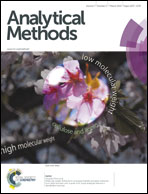Highly sensitive electrochemical sensor for dopamine with a double-stranded deoxyribonucleic acid/gold nanoparticle/graphene modified electrode†
Abstract
In this paper a novel electrochemical sensor was fabricated for the sensitive detection of dopamine (DA). By using a carbon ionic liquid electrode (CILE) as the substrate electrode, graphene (GR), gold nanoparticles (AuNPs) and double-stranded deoxyribonucleic acid (dsDNA) were electrodeposited on the surface of CILE step-by-step to obtain the modified electrode (dsDNA/Au/GR/CILE). Due to the presence of various modifiers on the electrode surface, the modified electrode exhibited specific synergistic effects, such as high conductivity and large surface of GR, good conductivity and biocompatibility of AuNPs, and the specific binding effect of dsDNA with the target analyte DA. Cyclic voltammetric studies indicated that a pair of well-defined redox peaks of DA appeared on dsDNA/Au/GR/CILE in pH 6.0 phosphate buffer solution and electrochemical behaviors of DA were carefully investigated. Under the optimal conditions the oxidation peak current of DA was linearly related to DA concentration in the range from 0.04 μmol L−1 to 0.6 mmol L−1 with a detection limit of 19.0 nmol L−1 (3σ). The modified electrode displayed excellent selectivity and repeatability, and was further used to detect DA content in drug samples with satisfactory results.


 Please wait while we load your content...
Please wait while we load your content...